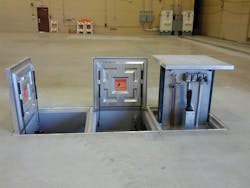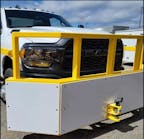My love for ground support equipment started from a dislike of ground support equipment. I started my aviation career as an airline pilot. I did most of my flying on the East Coast with quick turn operations.
I loved the flying. What I didn’t care much for was maintenance delays, and the worst kind would be damage caused by GSE. While inoperative APUs, auto breaks, and reverser buckets would slow us down, a fuel truck, baggage tractor or LAV truck hitting the fuselage will take the aircraft off line for days.
I could tell you stories for days about GSE damage to aircraft I witnessed, but one sticks with me. I was called to pick up a MD 80 grounded in Miami and ferry it unpressurized to Pittsburgh to get fixed.
When I arrived in Miami I grabbed the ferry permit and weather and proceeded to preflight the aircraft. I came across a softball-sized hole in the skin of the aircraft. The local maintenance crew met me before I was done and told me the aircraft was hit by a piece of GSE servicing the aircraft that morning and they went on to say they were going to tape the hole with speed tape. I looked around at the adjacent gates and saw a traffic jam of service equipment rushing around to turn the other aircraft. I could see very easily how this could happen.
Proceeding on, it hit me that the aircraft we are ferrying can’t pressurize. This means we can’t fly very high. In fact not only could we not fly above 18,000 feet, we had to fly the more zigzag lower altitude airways. So we take off and quickly accelerate to our max speed of 250 KTS.
I didn’t mind the slower speed or even the huge waste of fuel flying so low. But all the doors and flight deck window seals without pressurzation were whistling so loud, we had to yell to each other to hear. Four hours later we arrived in Pittsburgh. With a pretty good headache, I turned over the aircraft to the hangar maintenance crew. Before I made my way to the terminal to return home I asked one of the seasoned maintenance guys if this was something he'd seen often. To my surprise, he said this was not uncommon. He said people in a hurry - coupled with bad visibility, congestion and confusion - all seemed to be the reasons they kept his metal shop busy.
Events and days like this made is what made me dislike GSE, But it started to make me more aware of cities that handled their aircraft service more efficiently than others, which got me thinking about the GSE industry I eventually ended up in.
NEW CAREER
With thousands of my fellow pilots being furloughed and with aircraft parked on unused runways we looked for new careers. Initially I wanted to stay in aviation until my furlough callback. But a year later, I started to feel more at home in ground support. Thinking back to that ferry flight and with my line experience I started to think about how I could help the ramp congestion. At the same time I was looking at how to reduce ramp congestion while even more equipment requirements were being added like PC Air and 400HZ.
The first attempt was a design I called the External APU. I packaged any power supply and air supply that the APU on the aircraft would be supplying while parked at the gate into one single mobile unit. The idea was to combine a diesel GPU and a separate diesel PC Air unit into one all-in-one design.
I figured this would also limit the need for multiple towing tractors as well. This idea worked for open ramp areas and cut down the equipment by one piece. I then spent hundreds of hours looking at how to better integrate GSE on a passenger boarding bridge. Several good ideas were tried but the bridge market remained consistent to what they have done for decades such as hanging boxes, cables, baskets, remotes and pantographs all over the bridge. While functional, it is a mess in general. Cables and hoses still need to be stretched out to 60 feet or more.
After that, I started to get involved in military hangars. I got involved in one of the most advanced military hangars in the world at MCAS Yuma. I quickly learned that you could take a ton of service equipment, place it right where it needs to be and hide it.
A few 2 foot by 2 foot or 3 foot by 3 foot squares in the ground can hold more service points than even any passenger boarding bridge can. Fuel, all types of power like 120V, 480V, 400HZ, PC Air, shop air, potable water, LAV fill and dump and more. I was very excited to see this simple solution work so well. These underground gems finally sparked my interest to the fullest. I really started to think this is the magic that needs to be promoted.
EYE-OPENER
After a few years supplying these underground systems, simply and primitively called PITS, I realized what could happen after you stop calling them a hole in the ground with a lid and started to see what it can do for your operations. It starts to open eyes.
In the United States, this technology is mostly accepted today in the aviation industry for hangars applications and for airports fueling applications. Head east across the Atlantic and you can find all types of PITS being used everywhere.
The Middle East uses PITS on almost every new airport gate, ramp and hangar designs, and I can see so many good reasons for this.
Think back to my Miami story. A congested ramp with quick turns. And while safety is always No. 1, aircraft sitting at the gates are not generating revenue. There is a reason for a quick turn and that is to keep the aircraft usage maximized for profit.
So what if in Miami not only the fuel was underground but the 400HZ, the PCA, the LAV service and the potable water was also underground? How many positive things does this do? The aircraft still needs all these services, but why does a truck have to delivery them within feet of the thin-skinned aircraft? PITS can be placed in the right locations so that hook ups are quick. These PITS can cut the traffic around the aircraft in half.
Underground (GSE) Service Points or USP might make the industry think about what these holes in the ground can offer. No matter what you call it or think about it, they are a very viable solution to reducing GSE equipment moving around aircraft and quite possibly, had this technology been around in Miami that day I would have never been flying an MD 80 costing the airline 10s of thousands in costs and lost revenue up the east coast that day.
About the author: Bryan Bullerdick is president of B GSE Group, LLC and a former ATP commercial pilot.






